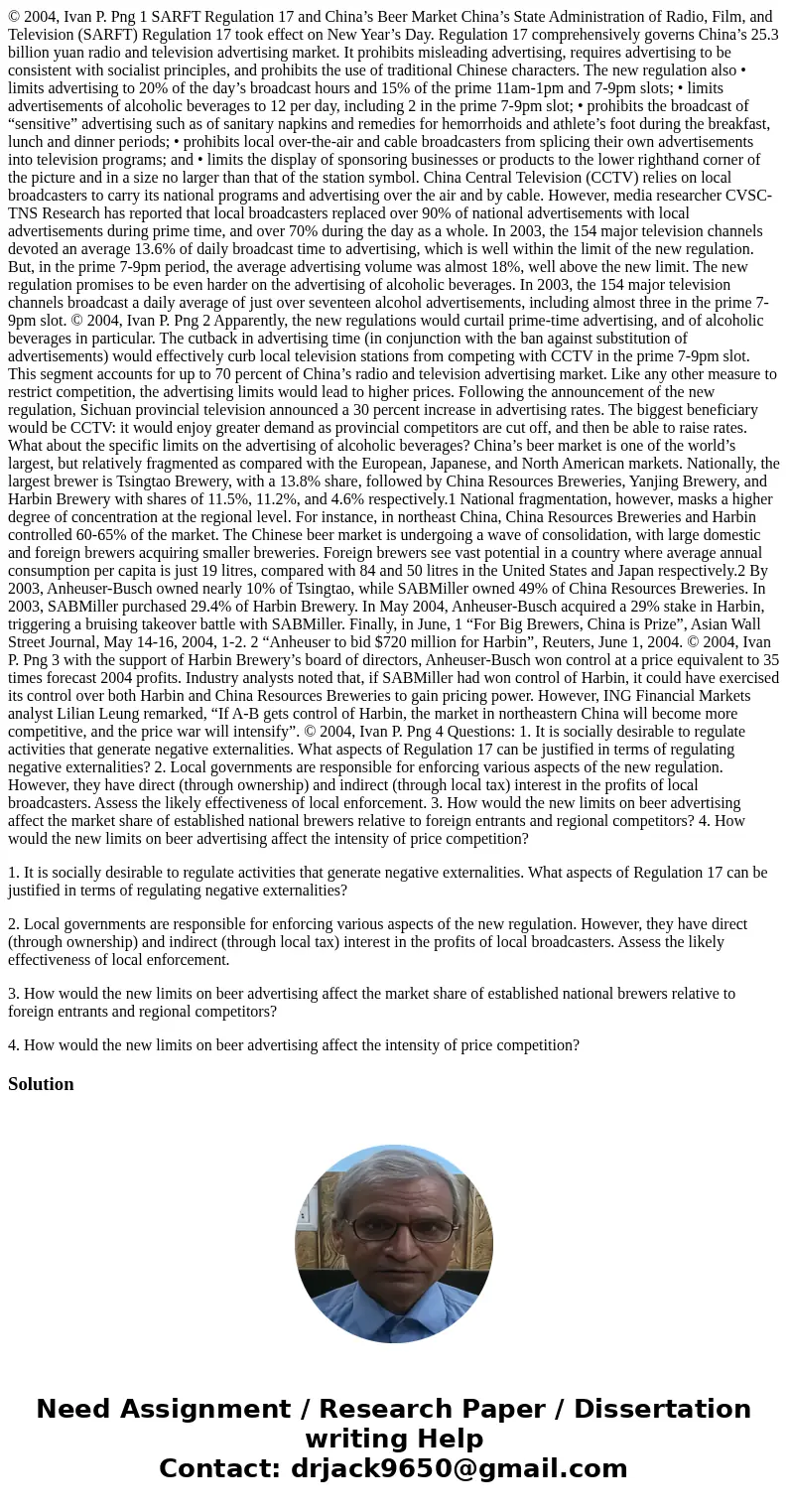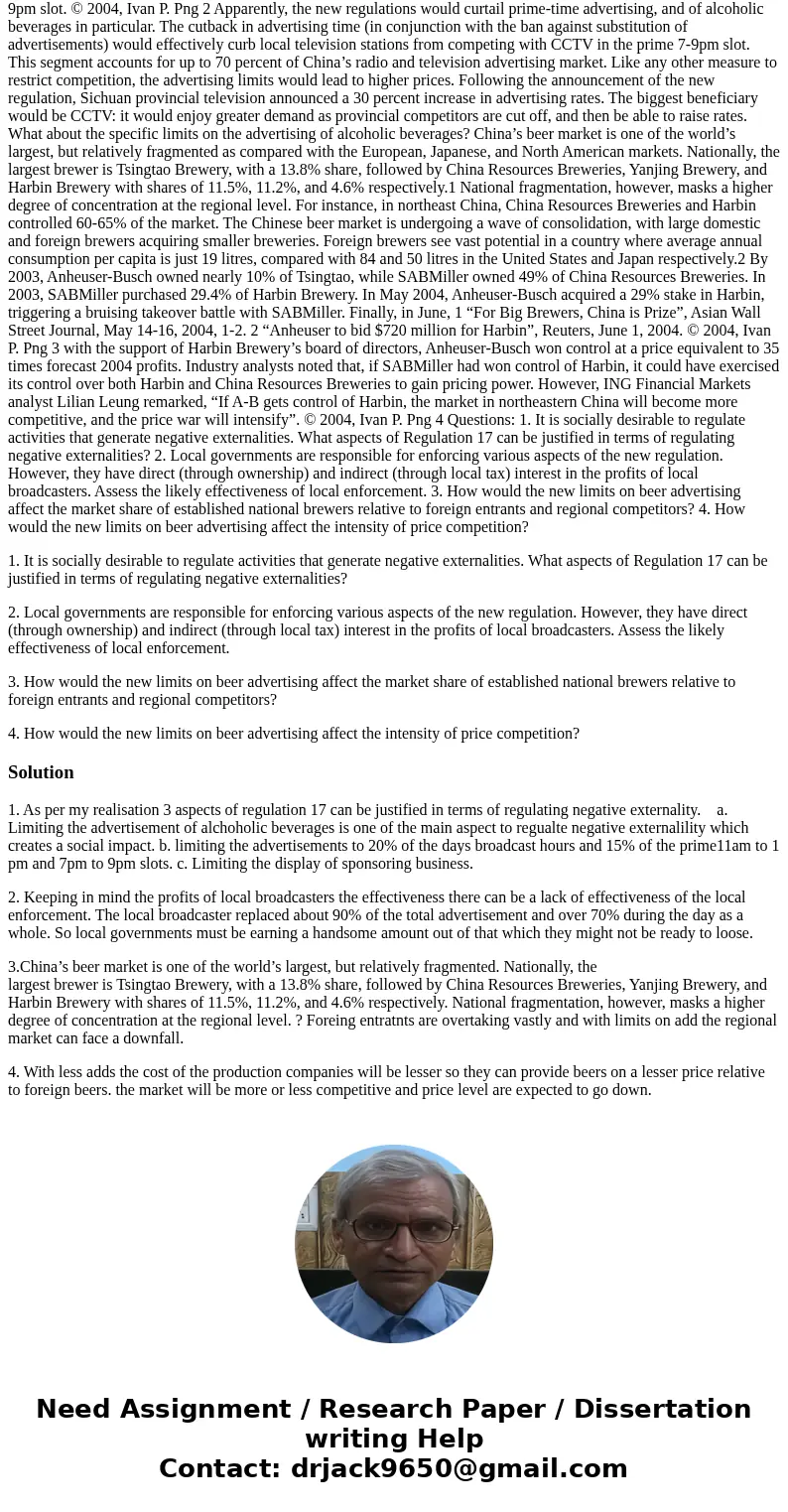2004 Ivan P Png 1 SARFT Regulation 17 and Chinas Beer Marke
© 2004, Ivan P. Png 1 SARFT Regulation 17 and China’s Beer Market China’s State Administration of Radio, Film, and Television (SARFT) Regulation 17 took effect on New Year’s Day. Regulation 17 comprehensively governs China’s 25.3 billion yuan radio and television advertising market. It prohibits misleading advertising, requires advertising to be consistent with socialist principles, and prohibits the use of traditional Chinese characters. The new regulation also • limits advertising to 20% of the day’s broadcast hours and 15% of the prime 11am-1pm and 7-9pm slots; • limits advertisements of alcoholic beverages to 12 per day, including 2 in the prime 7-9pm slot; • prohibits the broadcast of “sensitive” advertising such as of sanitary napkins and remedies for hemorrhoids and athlete’s foot during the breakfast, lunch and dinner periods; • prohibits local over-the-air and cable broadcasters from splicing their own advertisements into television programs; and • limits the display of sponsoring businesses or products to the lower righthand corner of the picture and in a size no larger than that of the station symbol. China Central Television (CCTV) relies on local broadcasters to carry its national programs and advertising over the air and by cable. However, media researcher CVSC-TNS Research has reported that local broadcasters replaced over 90% of national advertisements with local advertisements during prime time, and over 70% during the day as a whole. In 2003, the 154 major television channels devoted an average 13.6% of daily broadcast time to advertising, which is well within the limit of the new regulation. But, in the prime 7-9pm period, the average advertising volume was almost 18%, well above the new limit. The new regulation promises to be even harder on the advertising of alcoholic beverages. In 2003, the 154 major television channels broadcast a daily average of just over seventeen alcohol advertisements, including almost three in the prime 7-9pm slot. © 2004, Ivan P. Png 2 Apparently, the new regulations would curtail prime-time advertising, and of alcoholic beverages in particular. The cutback in advertising time (in conjunction with the ban against substitution of advertisements) would effectively curb local television stations from competing with CCTV in the prime 7-9pm slot. This segment accounts for up to 70 percent of China’s radio and television advertising market. Like any other measure to restrict competition, the advertising limits would lead to higher prices. Following the announcement of the new regulation, Sichuan provincial television announced a 30 percent increase in advertising rates. The biggest beneficiary would be CCTV: it would enjoy greater demand as provincial competitors are cut off, and then be able to raise rates. What about the specific limits on the advertising of alcoholic beverages? China’s beer market is one of the world’s largest, but relatively fragmented as compared with the European, Japanese, and North American markets. Nationally, the largest brewer is Tsingtao Brewery, with a 13.8% share, followed by China Resources Breweries, Yanjing Brewery, and Harbin Brewery with shares of 11.5%, 11.2%, and 4.6% respectively.1 National fragmentation, however, masks a higher degree of concentration at the regional level. For instance, in northeast China, China Resources Breweries and Harbin controlled 60-65% of the market. The Chinese beer market is undergoing a wave of consolidation, with large domestic and foreign brewers acquiring smaller breweries. Foreign brewers see vast potential in a country where average annual consumption per capita is just 19 litres, compared with 84 and 50 litres in the United States and Japan respectively.2 By 2003, Anheuser-Busch owned nearly 10% of Tsingtao, while SABMiller owned 49% of China Resources Breweries. In 2003, SABMiller purchased 29.4% of Harbin Brewery. In May 2004, Anheuser-Busch acquired a 29% stake in Harbin, triggering a bruising takeover battle with SABMiller. Finally, in June, 1 “For Big Brewers, China is Prize”, Asian Wall Street Journal, May 14-16, 2004, 1-2. 2 “Anheuser to bid $720 million for Harbin”, Reuters, June 1, 2004. © 2004, Ivan P. Png 3 with the support of Harbin Brewery’s board of directors, Anheuser-Busch won control at a price equivalent to 35 times forecast 2004 profits. Industry analysts noted that, if SABMiller had won control of Harbin, it could have exercised its control over both Harbin and China Resources Breweries to gain pricing power. However, ING Financial Markets analyst Lilian Leung remarked, “If A-B gets control of Harbin, the market in northeastern China will become more competitive, and the price war will intensify”. © 2004, Ivan P. Png 4 Questions: 1. It is socially desirable to regulate activities that generate negative externalities. What aspects of Regulation 17 can be justified in terms of regulating negative externalities? 2. Local governments are responsible for enforcing various aspects of the new regulation. However, they have direct (through ownership) and indirect (through local tax) interest in the profits of local broadcasters. Assess the likely effectiveness of local enforcement. 3. How would the new limits on beer advertising affect the market share of established national brewers relative to foreign entrants and regional competitors? 4. How would the new limits on beer advertising affect the intensity of price competition?
1. It is socially desirable to regulate activities that generate negative externalities. What aspects of Regulation 17 can be justified in terms of regulating negative externalities?
2. Local governments are responsible for enforcing various aspects of the new regulation. However, they have direct (through ownership) and indirect (through local tax) interest in the profits of local broadcasters. Assess the likely effectiveness of local enforcement.
3. How would the new limits on beer advertising affect the market share of established national brewers relative to foreign entrants and regional competitors?
4. How would the new limits on beer advertising affect the intensity of price competition?
Solution
1. As per my realisation 3 aspects of regulation 17 can be justified in terms of regulating negative externality. a. Limiting the advertisement of alchoholic beverages is one of the main aspect to regualte negative externalility which creates a social impact. b. limiting the advertisements to 20% of the days broadcast hours and 15% of the prime11am to 1 pm and 7pm to 9pm slots. c. Limiting the display of sponsoring business.
2. Keeping in mind the profits of local broadcasters the effectiveness there can be a lack of effectiveness of the local enforcement. The local broadcaster replaced about 90% of the total advertisement and over 70% during the day as a whole. So local governments must be earning a handsome amount out of that which they might not be ready to loose.
3.China’s beer market is one of the world’s largest, but relatively fragmented. Nationally, the
largest brewer is Tsingtao Brewery, with a 13.8% share, followed by China Resources Breweries, Yanjing Brewery, and Harbin Brewery with shares of 11.5%, 11.2%, and 4.6% respectively. National fragmentation, however, masks a higher degree of concentration at the regional level. ? Foreing entratnts are overtaking vastly and with limits on add the regional market can face a downfall.
4. With less adds the cost of the production companies will be lesser so they can provide beers on a lesser price relative to foreign beers. the market will be more or less competitive and price level are expected to go down.


 Homework Sourse
Homework Sourse